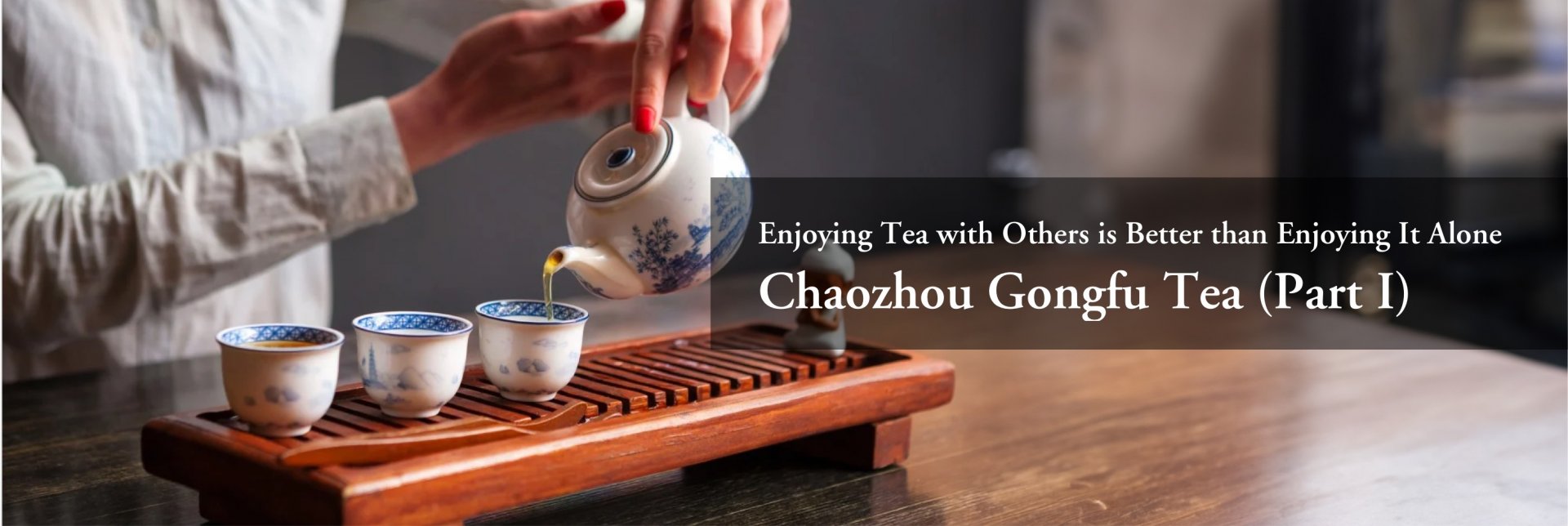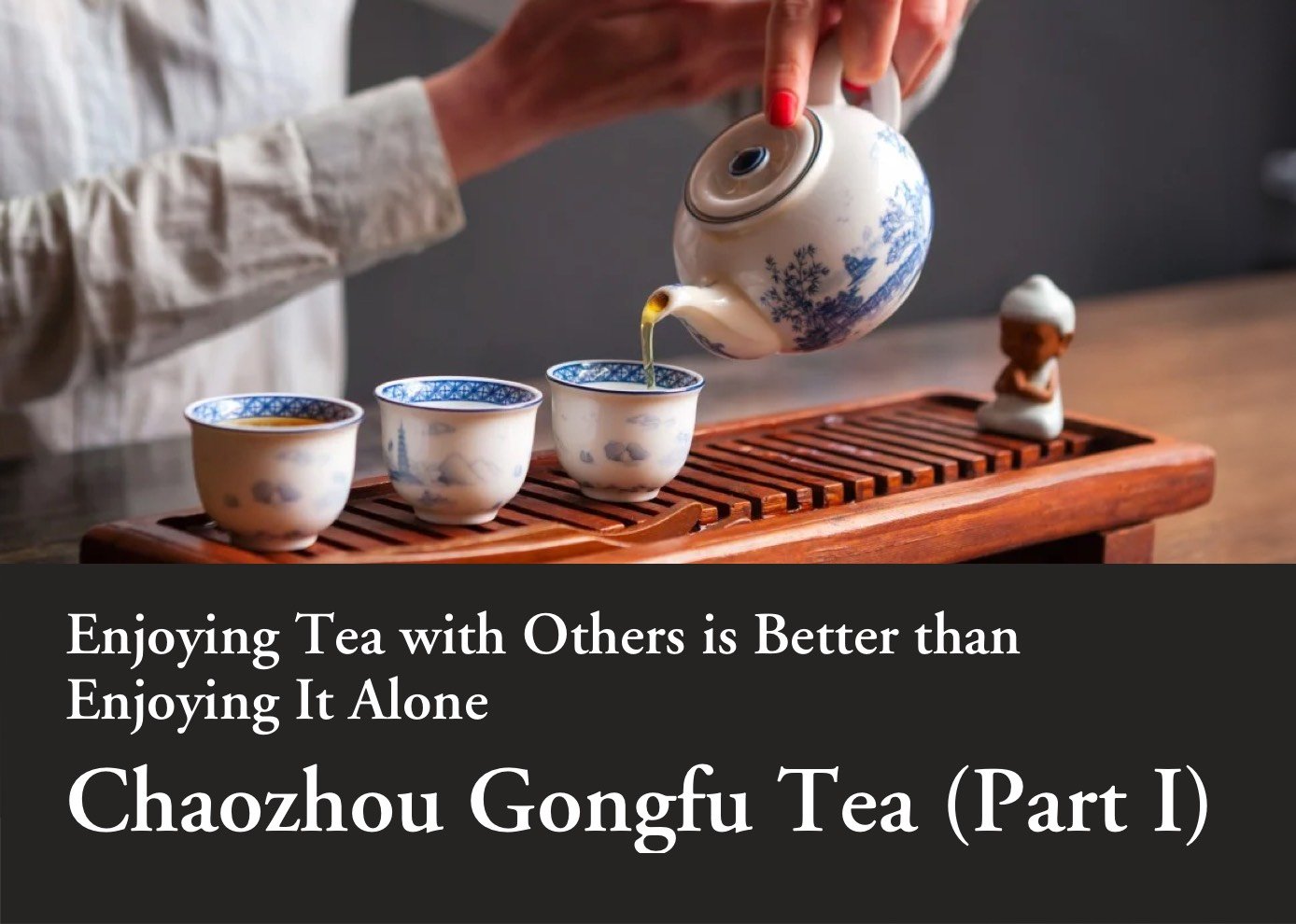Enjoying Tea with Others is Better than Enjoying It Alone — Chaozhou Gongfu Tea (Part I)
Chaozhou Gongfu tea comprises three different styles: tea art, tea ceremony, and tea practice.
Tea art pursues exquisite tea-processing skills while tea ceremony pursues the cultivation of the mind and temperament via tea. However, the so-called eighteen steps of Chaozhou Gongfu tea like white pottery stove, olive core charcoal and the crab-eye bubbles are actually only enjoyed by a few sons of rich families (“A-she” in Chaozhou dialect), and not widespread in Chaoshan families or streets. It is not real Gongfu tea in Chaozhou.
The real Chaozhou Gongfu tea is Di Cha (滴茶, tea practice), showing a lifestyle of cherishing leisure and valuing emotions through tea-drinking. “Come over to my house for a cup of tea when you’re free” and “although the tea is plain, we are hospitable and sincere” are common invitations among Chaozhou people. Chaozhou people often take a break from their busy schedules to gather with friends for tea. They chat over cups of tea, engaging in lively conversations to strengthen their bonds and deepen their friendships. Tea at this moment does not play the major part, friends, emotions, and leisure time are. Tea drinking here is not a practice of drinking alone but sharing. As the saying goes, “there must be some tea enthusiasts among those who drink tea together.” Enjoying tea with others means “getting together through tea drinking,” which is the real Chaozhou Gongfu tea.

Gongfu tea is not just tea itself
The name “Gongfu tea” first appeared in the records in the early Qing Dynasty (1616-1911). It originally referred to the finest rock tea in Fujian Province, later evolved into a process of tea drinking. In the early Ming Dynasty (1368-1644), Emperor Zhu Yuanzhang (朱元璋, 1368-1398) ordered to abolish compressed tea and promote loose-leaf tea, making tea available to the common people. Later, the oolong tea and Yue Yin (瀹飲), a simplified brewing method, came out. Based on the degree of fermentation, tea is classified mainly as non-fermented, partially fermented, and fully fermented tea. Oolong is a kind of partially fermented tea, also known as Qing Cha (青茶). Brewing loose-leaf tea directly with boiling water is called Yue Yin. Later, with the popularity of Yixing (宜興) purple clay teapots, brewing oolong tea with small pots and cups became known as Gongfu tea.
On this basis, men of letters developed sets of rigorous tea etiquette, including 18, 21 or 23 steps. From selecting water and utensils to controlling the fire for brewing, the whole process strived for perfection and meticulousness, which is now referred to as the Gongfu tea art or tea ceremony. Either for the pursuit of exquisite tea-tasting skills, or the experience of interacting between humanity and nature, different schools of Gongfu tea emerged among Fujian, Taiwan, and Chaozhou regions.
Gongfu tea is not originally created by the Chaozhou people. Instead, it comes from Fujian according to some early records. Gongfu tea is not exclusively enjoyed by Chaozhou people either. Instead, there are ever growing enthusiasts in Fujian, Taiwan, and all the other places in China even the world. However, the reason why Gongfu tea is named after “Chaozhou” is that Chaozhou people simplify it, and make it a part of daily life. Everyone in Chaozhou drinks tea wherever and whenever they like. Chaozhou people and Chaozhou tea are thus synonyms.

Tea practice in daily life
Tea practice is different from tea art or tea ceremony, which are two different concepts with different connotations. Tea art or tea ceremony can be enjoyed alone, but tea practice must be enjoyed with others. Tea art or tea ceremony is like a fine brushwork painting in elaborate style while tea practice is like a painting in impressionistic style. Tea art or tea ceremony emphasizes the environment, atmosphere, and utensils while tea practice is more casual. Tea art or tea ceremony helps to cultivate the mind while tea practice offers people chances to cherish leisure and express minds. Tea art or tea ceremony is elegant while tea practice is both elegant and commonplace. Tea art or tea ceremony is a “luxury item” while tea practice is a “daily necessity”. Tea art or tea ceremony aims for self-cultivation while tea practice makes a real life.
Tea art or tea ceremony is something beyond the enjoyment of ordinary people. Tea practice in Chaozhou, however, may take people only fifteen minutes to enjoy “the first infusion of tea”, so it is accessible for everyone. Therefore, Gongfu tea is named after “Chaozhou” because Chaoshan people would like to drink tea anytime, anywhere, and “drink it from morning till night”, not because they have superb brewing skills. Wherever they go, Chaozhou people must pack simple tea sets in the luggage because “wherever they go, they will drink tea”.
Gongfu tea is not a type of tea; but a practice of tea drinking. Chaozhou Gongfu tea ignores the complexity and is becoming part of people’s daily life. It is a daily habit of Chaoshan people, natural and indispensable like air. Life is the Way, and living naturally is the supreme Way. In this sense, we can say that life is culture and culture is life.
All articles/videos are prohibited from reproducing without the permission of the copyright holder.




Welcome to leave a message:
Please Sign In/Sign Up as a member and leave a message